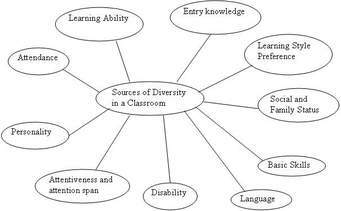e-Learning Ecologies MOOC’s Updates
Learner Diversity and the Conditions of Learning
The two most essential teaching principles I learned from my former Education teachers are: first, teachers start where the students are, and second, teachers should know the nature of their students. I believe that the first principle encompasses the teacher's adaptive use of his/her instructional knowledge, skills, and attitudes adjusting to the level of students' readiness and performance, while the latter implies understanding learner differences.
Learner differences should be understood not only in terms of how students differ in age, gender, socio-economic status, language, and ethnic background, but also in terms of their readiness to understand what is being taught, their motivation to learn, and their learning styles and preferences. Learning, however, is not simply about recognizing and affirming difference according to Kalantzis and Cope. They also emphasize that there are two conditions of learning in a context of deep and multifaceted diversity (https://newlearningonline.com/learning-by-design/learner-diversity):
Condition 1: Effective learning engages the learner’s identity. It builds on the learner’s knowledge, experiences, interests and motivation. In any learning community, there is a great deal of diversity, and this is because the everyday lifeworlds from which students come are always varied. A pedagogy of BELONGING brings this diversity into the classroom, values it and uses it as a resource for learning.
Condition 2: Effective learning takes the learner on a journey into new and unfamiliar terrains. However, for learning to occur the journey into the unfamiliar needs to stay with a zone of intelligibility and safety. At each step, it needs to travel just the right distance from the learner’s lifeworld starting point. A pedagogy of TRANSFORMATION takes learners out of their comfort zones, as a result of which they form new frames of understanding, ways of meaning, capacities to act and expressions of identity.
As learners differ in many ways and in many circumstances, teachers cannot continue using the same instructional strategies in a one-size-fits-all manner. Considering these two conditions brings to fore what should be factored when designing instructions to become adaptive and flexible- one that cosiders learner differences. A pedagogy of BELONGING considers inclusive strategies- one that considers all students regardless of their background and one that celebrates such differences. Instead of looking for weaknesses, strengths are valued. Instead of looking at isolation and looking at differences as weird, uniqueness with complementation is desired. Hence, instead of too much comptetition, students are guided to collaborate in tasks and to value collective intelligence in meaning-making. Such activities make the students feel that they have a voice that is being heard by other people. They have the opportunity to discover their identity in the process, without undermining their own potentials. To belong means to have a proper, appropriate, or suitable place; to be naturally associated with something; to fit into a group naturally “Webster’s New Collegiate Dictionary. This feeling is crucial in developing students' confidence amid differences.
The second condition, "a pedagogy of TRANSFORMATION takes learners out of their comfort zones, as a result of which they form new frames of understanding, ways of meaning, capacities to act and expressions of identity."
Teaching strategies that afford such transformation offer students different perspectives and allow them the opportunity to weigh pros and cons, and to examine the relevance, utility, and beneficialty (among other criteria) of these perspectives to their own lives. These are tasks that lead them not to mere memorization of facts but ones that require the students to examine critically those facts in order to make wise decisions. In the process, they realize bigger pictures, macro perspectives and spaces, and their potentials thriving and adjusting to them. Great teachers allow the students not only to discover the learners' identity amidst diversity but also provide them opportunities to celebrate such uniqueness and become more responsible, rationale, and productive citizens in the process.
References:
Beck, M. & Malley, J. A pedagogy of belonging. Retrieved from https://www.cyc-net.org/cyc-online/cycol-0303-belonging.html
Doughlas-Faraci, Denise. (2013). Diversity of learners, differentiated instruction, and e-learning. retrieved from https://www.purdueglobal.edu/blog/education/elearning/
Kalantzis, M. & Cope, B. (n.d.). Learner diversity. Retrieved from https://newlearningonline.com/learning-by-design/learner-diversity
Learner diversity. Retrieved from https://int.search.tb.ask.com/search/AJimage.jhtml?&enc=0&n=7867aeee&p2=%5ECPC%5Echr999%5ETTAB03%5E&pg=AJimage&pn=1&ptb=C64936AB-A746-4A43-BA4D-82F350240762&qs=&searchfor=learner+diversity&si=&ss=sub&st=sb&tpr=sbt&imgs=1p&filter=on&imgDetail=true
Image for pedagogy of transformation. Retrieved from https://media4.picsearch.com/is?JxHNsyjrJdvBPTNIDotwtJ5xJz2G2BGsxcBebnKvcKI&height=227



